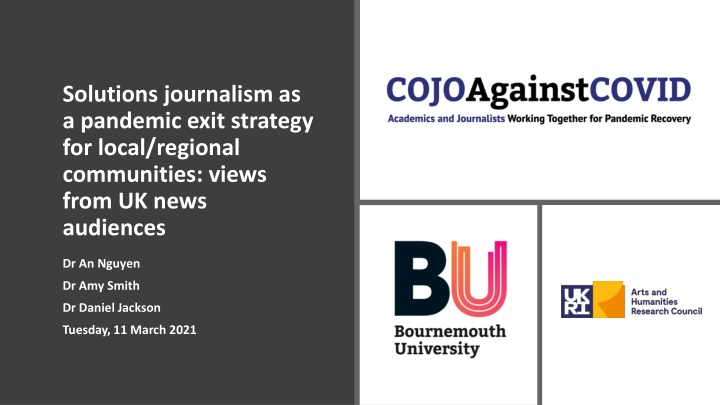
Pandemic Exit Strategy: Solutions Journalism for Local Communities in UK
Explore the potential of solutions journalism as an exit strategy for local and regional communities in the UK amidst the pandemic. Understand journalist opinions and challenges, along with audience responses to Constructive Journalism. Discover how positive framing and engagement can drive impact and action among audiences.
Download Presentation

Please find below an Image/Link to download the presentation.
The content on the website is provided AS IS for your information and personal use only. It may not be sold, licensed, or shared on other websites without obtaining consent from the author. If you encounter any issues during the download, it is possible that the publisher has removed the file from their server.
You are allowed to download the files provided on this website for personal or commercial use, subject to the condition that they are used lawfully. All files are the property of their respective owners.
The content on the website is provided AS IS for your information and personal use only. It may not be sold, licensed, or shared on other websites without obtaining consent from the author.
E N D
Presentation Transcript
Solutions journalism as a pandemic exit strategy for local/regional communities: views from UK news audiences Dr An Nguyen Dr Amy Smith Dr Daniel Jackson Tuesday, 11 March 2021
Existing Research: Interviews with Journalists What do journalists think and how do they use COJO?
Potential challenges to implementing COJO Newsroom culture and editors mindsets (K&P, 2018; Lough and Macintyre, 2018), Concerns about advocacy (K&P, 2018) Concerns about ideology (K&P, 2018). Potential roles for COJO: Regaining audience trust and engagement (Macintyre & Sobel, 2018; Kovacevic & Perisin, 2019; Allam, 2019; Lough and Macintyre, 2018) Serving public interest (Kovacevic & Perisin, 2019) Reviving the industry economy (Allam, 2019) Promoting stability and unity (K&P 2019; Allam, 2019) COJO is suited for a variety of different topics, but some might be better suited than others e.g. social justice or the environment. (Lough and Macintyre, 2018) Best Practice Tips (Lough and Macintyre, 2018) Maintain objectivity through rigorous reporting and use of evidence. Kept the same routines, but the thought process changed it shifted to a how focus, not just stopping at the issue but considering what the solutions were. Suggests making use of mind maps. Management support is key difficulty pitching to unsupportive editors
Existing research: Experiments with audiences How do audiences respond to COJO?
An experiment using 3 topics with two stories each: a COJO and a non-COJO approach. After reading, participants completed a survey on their emotion responses. Millennials, mood, and engagement (Hermans and Prins, 2020) What did the study find? Participants reported more positive emotions and fewer negative emotions when they read a constructive news article. There were more inspirational emotions reported amongst those who read a constructive story. The story topic had a positive effect. Takeaways? IMPACT: constructive news can have more impact if it resonates with the readers lives. FRAMING: By using solution-, future-, and action-oriented perspectives in news, journalists are expected to connect better with Millennials needs for news that helps them connect and progress in life. (p.15) SUPPORTING ACTION: Participants were given the option to engage with the story through working buttons to like (30.2%), place comment (5.3%), share (9.4%) or act (12.6%). When audiences are actually given options to participate, they take action.
Experiment using university students as participants engaging with a fictitious news site. Participants were divided into 2 groups and given either (1) a relevant story about tuition fees or (2) a story about graffiti, with a range of effective, ineffective, and no solutions. What did the study find? All solution-oriented stories increased improved the participants moods. Participants who read a story with an effective solution reported more favourable attitudes about the story than did those who read a story with no solution. HOWEVER the presence of solutions in stories did not significantly impact intention to act. BUT ALSO, including solution information in the stories did not cause the readers to perceive the story as less in line with journalism s core functions. Topic, relevance & emotion (Macintyre, 2019) Takeaways POSITIVE EMOTIONS: Discussing an effective solution to a social problem in news story caused readers to feel less negative and report more favourable attitudes toward the news article and toward solutions to the problem than when no solution or an ineffective solution was mentioned. (p.29) FRAMING: Ineffective solutions were found to leave the participants feels more hopeless, so consider framing the story as a problem in which people care enough to try and solve it, and even though their particular solution is not effective, there is still hope. (p.30)
Experiment where 259 participants read stories on 2 topics (the environment and war/peace) using different frames: catastrophe-frame, solution-frame, positive tone, and negative tone. What were the findings? Exposure to positive news stories resulted in more positive affect than to negative news stories. Exposure to constructive news stories resulted in higher motivation to take positive actions. Catastrophically framed stories and news stories that evoked negative emotions reduced intentions to take positive action to address issues solution-framed stories and news stories that evoked positive emotions resulted in more positive affect and higher intentions to take positive action. COJO, framing and impact on audience behaviour (Baden, Macintyre and Homberg, 2019) Takeaways SOCIETAL BENEFITS: Adopting a societal perspective, the results indicate that a move toward more constructive and less alarmist journalism would be beneficial for society (p.1954) The social responsibility theory of the press asserts that the media have a responsibility to consider society s best interest it is concluded that constructive journalism needs to be seen as more than a nice to have and instead and essential part of news journalism. (p.1956)
Bournemouth University COJO Study Findings from our national survey and in- depth interviews with members of the public
Public opinions on problems & solutions in news The public thinks that journalism must focus on problems to: hold power to account (56%), keep society vigilant (55%) to create a collective will to overcome societal problems (51%) 41% participants thought that solution-oriented news should not be done at the expense of problems-focused news , but (46%) were unsure about this. Reassurance to newsrooms who practice solutions journalism alongside or as part of their fourth estate role
COJO has a positive impact on audiences Previous studies to examine audience perceptions of solution-oriented journalism have found: Greater positive affect and higher motivation to take positive actions (e.g. Baden, McIntyre, and Homberg 2019) increased optimism and empowerment (e.g. Gielan, Furl, and Jackson 2017), and enhanced interest in similar stories (e.g. McIntyre and Sobel 2017).
COJO can empower audiences to engage with societal problems 49% felt that solution-oriented news can inspire them to take action. seems much more beneficial to the public consuming the information because rather than being bombarded with negativity, people can be informed on situations and more importantly how they can help and how others can help (Anonymous). I think it will open up more informed debate If somebody is really trying to find a solution, you debate around that solution to make it better. It s like a starting point, rather than just having this black wall of the problem that everybody chucks off stupid things into ... So, I think it actually involves a wider audience in developing the solution. (Helen).
COJO can help COJO can help increase interest and increase interest and engagement engagement 52% participants agreed that this type of news can increase their interest in news. This opens up the possibility that beyond the audience benefits of solutions journalism, that it can also be a commercial strategy too.
COJO can increase optimism and hope More than half of the participants thought that the news could: help them to imagine a better world (58%) bring positive changes to society (54%) create more hope (53%). Solutions-oriented journalism ...offer[s] optimism and inspiration to boost people and offer solutions, and would provide some people with hope that bad situations will get better with time and collective effort. (survey respondent) Interviewees expressed similar opinions: Solutions-focused journalism ...would encourage people to be more proactive and realise that there is more that people can do, and there are ways people can improve things and might change people s psychology to be a bit more positive about the world. (Mikaela);
Usefulness in Pandemic Recovery Consistent with the survey findings, our interviewees also acknowledged the potential positive impact of solutions-oriented news in the context of the pandemic. Again, themes of positive mood, optimism, and confidence emerged in these interviews. It ll help people a lot psychologically, because I think that there s still people that have a lot of anxiety regarding the virus and the vaccinations. If solutions journalism is providing the all-round story, it will give people theconfidence to make certain decisions regarding particular things so it will help them psychologically. To recover from some of the damage that has been done from the constant negative news as well (Nigel) Interviewees also acknowledged the role of solution-oriented journalism in motivating actions, for example, in the local community building during the pandemic recovery. For example, It s getting people more engaged in things...on a local level, which can often be influencing...let s say you re highlighting a story on...local economy in a particular town. A lot of people get engaged in that it might bring people into...spending money in those areas, encouraging local businesses to improve...it would be beneficial especially getting more people engaged (Alexander);
Where should local reporters focus? Suggestions from our in-depth interviews
So I think they [could have] positive spin on things [that] would do the local councils some good going forward. I don't know whether [local newspapers] focus on things like the climate change or air quality and stuff like that. And you know, more people working from home has improved the air quality in the city which is improving our health . (Alec) I think Councils need to encourage ways of promoting sort of healthy lifestyles and healthy livingso people that can be negatively affected a lot less in that aspect as well . (Alexander) I think a for a lot of people it would be economic difficulties that would be quite key. You know going through different solutions that [show how] they can, for example, consolidate their debt not everybody's a finance person, but if there's somebody explaining it to them and telling them their solutions that that would be really helpful, I think. (Toby) [Local newspapers] sometimes get local women who set up their own businesses and write articles on them, on how they did it, how they got started, you know the real basics on what they've done I quite find it inspiring that a lot of these people, maybe came from nothing, they were brave and just thought right, I can do this . I think that sort of thing would be quite inspiring to other people locally, especially considering job losses and people being worried about business closing down with the whole pandemic. (Anne)
The research shows that: Constructive journalism, especially solutions journalism, can create more positive emotions amongst audiences. Audiences respond well to COJO: they are more likely to take action, engage, and think positively of the media. There are still some challenges: Think carefully about framing, certain topics resonate more strongly with different demographics. Consider your newsroom routines and culture, and how COJO can fit into (or challenge) these. Maintain objectivity by using evidence, and interrogating the solutions you find. Audiences report that all topics can benefit from COJO, so focus on priorities for your community. Final thoughts & key takeaways
How do you think solutions-focussed journalism can help your local community? Has anyone got experience of solutions- focussed journalism? What do you think are the main obstacles to solutions-focussed journalism in your newsrooms? Questions to consider






















